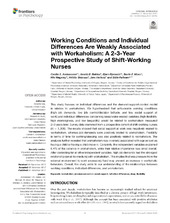| dc.contributor.author | Andreassen, Cecilie Schou | |
| dc.contributor.author | Bakker, Arnold B. | |
| dc.contributor.author | Bjorvatn, Bjørn | |
| dc.contributor.author | Moen, Bente Elisabeth | |
| dc.contributor.author | Magerøy, Nils | |
| dc.contributor.author | Shimazu, Akihito | |
| dc.contributor.author | Hetland, Jørn | |
| dc.contributor.author | Pallesen, Ståle | |
| dc.date.accessioned | 2018-08-17T12:31:29Z | |
| dc.date.available | 2018-08-17T12:31:29Z | |
| dc.date.issued | 2017-11-21 | |
| dc.Published | Andreassen CS, Bakker AB, Bjorvatn B, Moen BE, Magerøy N, Shimazu, Hetland J, Pallesen S. Working conditions and individual differences are weakly associated with workaholism: A 2-3-year prospective study of shift-working nurses. Frontiers in Psychology. 2017;8:2045 | eng |
| dc.identifier.issn | 1664-1078 | |
| dc.identifier.uri | https://hdl.handle.net/1956/18139 | |
| dc.description.abstract | This study focuses on individual differences and the demand-support-control model in relation to workaholism. We hypothesized that unfavorable working conditions (high job demands, low job control/decision latitude, and low social support at work) and individual differences concerning sleep/wake-related variables (high flexibility, high morningness, and low languidity) would be related to workaholism measured 2–3 years later. Survey data stemmed from a prospective cohort of shift-working nurses (N = 1,308). The results showed that social support at work was negatively related to workaholism, whereas job demands were positively related to workaholism. Flexibility in terms of time for working/sleeping was also positively related to workaholism. The analyses further revealed that workaholism was inversely associated with age as well as having a child or having a child move in. Conjointly, the independent variables explained 6.4% of the variance in workaholism, while their relative importance was small overall. After controlling for all other independent variables, high job demands had the strongest relationship (small-to-medium) with workaholism. This implies that less pressure from the external environment to work excessively hard may prevent an increase in workaholic behaviors. Overall, the study adds to our understanding of the relationships between working conditions, individual differences, and workaholism. | en_US |
| dc.language.iso | eng | eng |
| dc.publisher | Frontiers | eng |
| dc.rights | Attribution CC BY | eng |
| dc.rights.uri | http://creativecommons.org/licenses/by/4.0 | eng |
| dc.subject | workaholism | eng |
| dc.subject | job demand-control-social support | eng |
| dc.subject | individual differences | eng |
| dc.subject | sleep | eng |
| dc.subject | flexibility | eng |
| dc.title | Working conditions and individual differences are weakly associated with workaholism: A 2-3-year prospective study of shift-working nurses | eng |
| dc.type | Peer reviewed | |
| dc.type | Journal article | |
| dc.date.updated | 2018-03-07T14:21:41Z | |
| dc.description.version | publishedVersion | |
| dc.rights.holder | Copyright 2017 The Author(s) | eng |
| dc.identifier.doi | https://doi.org/10.3389/fpsyg.2017.02045 | |
| dc.identifier.cristin | 1514200 | |
| dc.source.journal | Frontiers in Psychology | |

